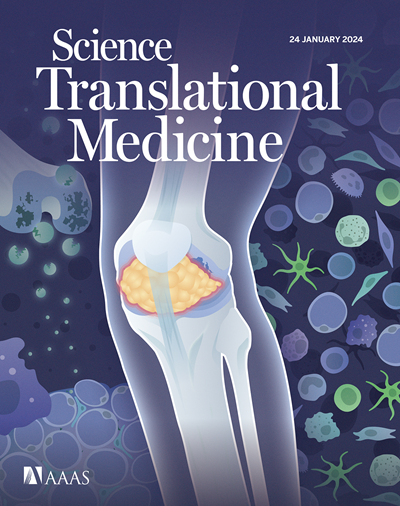针对n端和受体结合域的双特异性抗体可有效中和关注的SARS-CoV-2变体
IF 15.8
1区 医学
Q1 CELL BIOLOGY
引用次数: 0
摘要
严重急性呼吸综合征冠状病毒2 (SARS-CoV-2)关注变异体(VOCs)的不断出现会降低抗体治疗的有效性,因此有必要开发能够抵御病毒进化的下一代抗体模式。在这里,我们鉴定了先前从2019冠状病毒病(COVID-19)恢复期供者中分离的氨基末端结构域(NTD)和受体结合结构域(RBD)特异性单克隆抗体对突发SARS-CoV-2 VOCs的活性。其中,NTD特异性抗体C1596与VOCs结合的宽度最大,低温电镜结构分析显示在抗原超位点i外识别一个独特的NTD表位。鉴于C1596良好的结合特性,我们设计了一系列双特异性抗体(bsAbs),称为cov2 - birn,具有NTD和RBD特异性。两种包含c1596的bsab, CoV2-biRN5和CoV2-biRN7,对所有测试的Omicron变体(包括XBB.1.5, BA.2.86和JN.1)保留了有效的体外中和活性,与单一疗法或鸡尾酒疗法的亲本抗体的效力降低形成对比。此外,在感染SARS-CoV-2 XBB.1.5后,预防性递送CoV2-biRN5可降低K18-hACE2小鼠肺内的病毒载量。总之,NTD-RBD bsab为设计抗SARS-CoV-2 VOCs的弹性新一代抗体疗法提供了很好的潜力。本文章由计算机程序翻译,如有差异,请以英文原文为准。
Bispecific antibodies targeting the N-terminal and receptor binding domains potently neutralize SARS-CoV-2 variants of concern
The ongoing emergence of severe acute respiratory syndrome coronavirus 2 (SARS-CoV-2) variants of concern (VOCs) that reduce the effectiveness of antibody therapeutics necessitates development of next-generation antibody modalities that are resilient to viral evolution. Here, we characterized amino-terminal domain (NTD)– and receptor binding domain (RBD)–specific monoclonal antibodies previously isolated from coronavirus disease 2019 (COVID-19) convalescent donors for their activity against emergent SARS-CoV-2 VOCs. Among these, the NTD-specific antibody C1596 displayed the greatest breadth of binding to VOCs, with cryo–electron microscopy structural analysis revealing recognition of a distinct NTD epitope outside of the site i antigenic supersite. Given C1596’s favorable binding profile, we designed a series of bispecific antibodies (bsAbs), termed CoV2-biRNs, that featured both NTD and RBD specificities. Two of the C1596-inclusive bsAbs, CoV2-biRN5 and CoV2-biRN7, retained potent in vitro neutralization activity against all Omicron variants tested, including XBB.1.5, BA.2.86, and JN.1, contrasting the diminished potency of parental antibodies delivered as monotherapies or as a cocktail. Furthermore, prophylactic delivery of CoV2-biRN5 reduced the viral load within the lungs of K18-hACE2 mice after challenge with SARS-CoV-2 XBB.1.5. In conclusion, NTD-RBD bsAbs offer promising potential for the design of resilient, next-generation antibody therapeutics against SARS-CoV-2 VOCs.
求助全文
通过发布文献求助,成功后即可免费获取论文全文。
去求助
来源期刊

Science Translational Medicine
CELL BIOLOGY-MEDICINE, RESEARCH & EXPERIMENTAL
CiteScore
26.70
自引率
1.20%
发文量
309
审稿时长
1.7 months
期刊介绍:
Science Translational Medicine is an online journal that focuses on publishing research at the intersection of science, engineering, and medicine. The goal of the journal is to promote human health by providing a platform for researchers from various disciplines to communicate their latest advancements in biomedical, translational, and clinical research.
The journal aims to address the slow translation of scientific knowledge into effective treatments and health measures. It publishes articles that fill the knowledge gaps between preclinical research and medical applications, with a focus on accelerating the translation of knowledge into new ways of preventing, diagnosing, and treating human diseases.
The scope of Science Translational Medicine includes various areas such as cardiovascular disease, immunology/vaccines, metabolism/diabetes/obesity, neuroscience/neurology/psychiatry, cancer, infectious diseases, policy, behavior, bioengineering, chemical genomics/drug discovery, imaging, applied physical sciences, medical nanotechnology, drug delivery, biomarkers, gene therapy/regenerative medicine, toxicology and pharmacokinetics, data mining, cell culture, animal and human studies, medical informatics, and other interdisciplinary approaches to medicine.
The target audience of the journal includes researchers and management in academia, government, and the biotechnology and pharmaceutical industries. It is also relevant to physician scientists, regulators, policy makers, investors, business developers, and funding agencies.
 求助内容:
求助内容: 应助结果提醒方式:
应助结果提醒方式:


